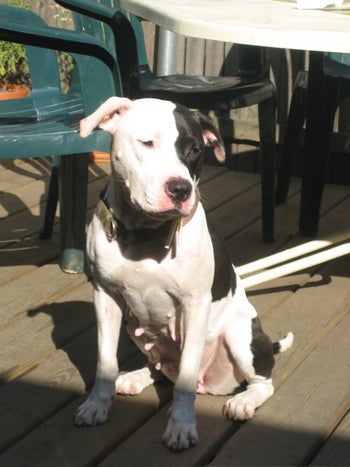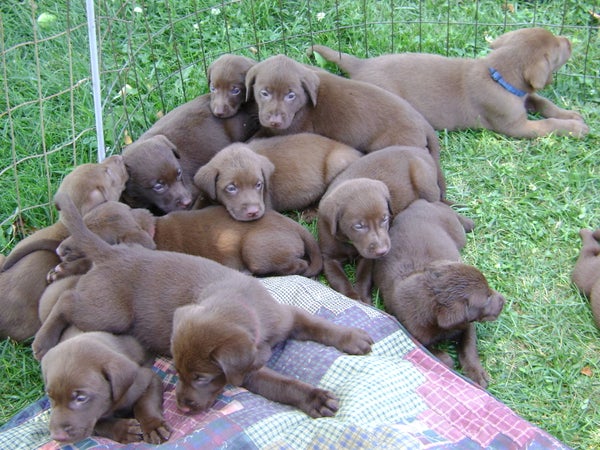This article was published in Scientific American’s former blog network and reflects the views of the author, not necessarily those of Scientific American
A few years back, on a night when I thought I was going to dinner with friends, I instead walked into a surprise party for me! My friends were covered in tartan patterns and kilts because I was on my way to the University of Edinburgh in Scotland for a Masters in Applied Animal Behaviour and Welfare. And since dogs are my bag, the goodbye cake featured a photo-quality image of one of my favorite dogs, Petunia, a somewhat odd selection, as dogs on cakes go.
Petunia was found abandoned in New York City in a sorry state with a massive goiter on her neck. The goiter was later treated so the cake image was goiter-free. Instead, the cake captured Petunia’s permanent parts: her black and white cow-like splotches, and of course, her huge nipples.
Dog nipples don’t attract attention until they feature prominently on a cake. Even then, there’s not much to say apart from, “Wow. That dog has really large nipples. And they’re on that cake.” But for researchers, there’s more to dog nipples than hoping you don’t get a piece of cake with nipples on it. Nipples — or, better said, nipple preference in young animals — has been investigated in numerous species to explore how they successfully access milk, a crucially important resource. And as we’ll see, there’s some confusion about how different young mammals do it.
On supporting science journalism
If you're enjoying this article, consider supporting our award-winning journalism by subscribing. By purchasing a subscription you are helping to ensure the future of impactful stories about the discoveries and ideas shaping our world today.

I couldn't find a picture of the cake, but here is Petunia and her nipples. Credit: Kelly Nadel
Milk time
Unlike precocial animals who are born essentially saying, “I got this. See ya,” altricial animals can’t make it on their own; they need considerable early-life care and provisioning to stay alive. In mammals, milk — accessed by nursing from the mother’s nipples — is crucial for survival. While this might seem simple enough — get milk, stay alive — the process can play out in a number of different ways. For example, imagine a species where numerous young are born at the same time. The young theoretically could compete for access to nipples, the source of an important, yet limited, resource. In fact, studies find that puppies gain less weight in larger litters and gain more weight if there are deaths in a litter.
Should Hollywood pick up on this theme, the resulting G-rated animated blockbuster might look like this: too many puppies are born in a litter and the competition is fierce, so a few of the puppies, led by Amy Schumer, embark on a perilous journey to find more milk. And they do! Another mamma dog, played by Meryl Streep, has just lost all her puppies in a freak accident (off-screen, of course), and the trekking puppies connect with the new mom just in the nick of time! PS: Suing if I see this idea anywhere.
Like most movies with talking dogs, that one’s not realistic. What do puppies actually do with nipples? Do they “[jockey] for position while nursing with the mother” as one self-proclaimed dog behavior specialist claims, or is something else going on? Researchers around the globe have teamed up to investigate the pre-weaning period, when young are dependent on a mother’s milk, and whether nipple preference and competition is the same across all altricial species. What is the state of nipple competition in different species?
Kittens on nipples
If you’re someone who calls fives on your favorite chair, kittens feel you. Newborn kittens show a clear preference for particular nipples and develop what’s referred to as a “teat order,” typically nursing from one or two specific nipples. Not only do preferences develop early in life, but contests for access to nipples continue, and kittens actively defend against littermates. Summary: My nipple.
Piglets on nipples
Numerous studies find that piglets behave similar to kittens and display “teat fidelity” where individuals interact mainly with one or two nipples. Very quickly after birth, piglets compete for nipples. But unlike kittens, many piglets soon reach a cease-fire. “Teat fidelity” helps reduce subsequent disputes over nipples, which could lead a piglet to miss a nursing. Summary: My nipple.
Puppies on nipples
Puppies did not get the same memo as kittens and piglets and do not show consistent use of or preference for particular nipples. Puppies instead latch onto many different nipples. Researchers observed very few incidents of “contest” behavior, such as a puppy pushing into a nursing littermate to dislodge them from a nipple, and they observed no incidence of “high-intensity contest behavior” like biting, growling or swiping at another puppy. Puppies suckled in a “seemingly haphazard manner” and not all at the same time. Some would suckle, others slept, others played, and others wandered around (in other words, all doing different cute things at the same time). Summary: Nipple shnipple.
The puppy observations come from a 2013 paper by Lourdes Arteaga and colleagues published in Ethology. The researchers investigated the pattern of nipple use in 10 different litters of puppies, 1 to 28 days of age. Since the litters were both mixed- and pure-bred (including five different breeds), these results are not thought to be breed-specific, but instead are generalizable across dogs.
They are all equally adorable, but there is not one singular pattern of nipple use across altricial mammals. Researchers continue to investigate what’s behind the differences. For example, Skok & Škorjanc suggest that the intense fighting between piglets immediately after birth could be about colostrum, a critical limited resource that pigs (ungulates) only access after birth due to their particular “route of maternal antibody transfer to the offspring.” Researchers also suggest that kitten nipple preference and contests might help to “optimize the number of nipples remaining productive across lactation, and to reduce energetically costly scrambles and potentially injurious contests among littermates.”
But what’s behind puppies' la-di-da approach to nursing? In a paper published earlier this year in the Journal of Comparative Psychology, Robyn Hudson and colleagues hypothesized that the pattern of chaotic, competition-free nursing behavior observed in dogs could be an artifact of the domestication process. The observed differences between kittens and puppies, they suggest, could be “due to different degrees of domestication,” with dogs under the thumb of domestication for considerably more time than cats, possibly resulting in “relaxed selection.” Or, they wondered, could the observed differences be due to lifestyle and phylogenetic differences between dogs and cats? To investigate these possibilities, they turned to the dingo, a canid that has been exposed to considerably less human influence than the dog. Would the dingo behave more like kittens or puppies?
Turns out the dingoes behaved exactly like the dogs! Bradley Smith, of Central Queensland University and one of the paper’s co-authors, shared over email, “Honestly, we had no idea whether or not dingoes would be the same as dogs. We were unsure whether the domestication process changed the nursing behaviour in dogs. Turns out that it hasn’t — dogs and dingoes were exactly the same.” Domestication didn’t do it. Smith adds, “It might be interesting to look at wolves, but I suspect they are no different to dogs and dingoes.”
With this new information in hand, the researchers suggest that observed differences between kittens and puppies are not an “artifact of domestication,” but instead represent lifestyle and phylogenetic differences. The researchers highlight that cats’ history as solitary hunters and obligate carnivores and dogs’ history as social, group-living omnivores sets the stage for differences in parental care and associated behaviors.
But our understanding of dogs is not always based on scientific findings. For example, Cesar Millan's website claims that dogs jockey for position while nursing, which is supposedly integral to "The source of dominance." The website goes on, "This position is so instinctual because dogs begin learning it almost from birth as the new litter jockeys for position while nursing with the mother. The more dominant dogs will get more milk while the submissive dogs will learn to wait. Since this first struggle for position deals with food and the possible difference between life and death, it is very primal and makes a big impact."
But that’s not what the study found. Early-life jockeying and competition was not observed in dogs! While researchers and animal behavior professionals continue to investigate and discuss the role of dominance in dog-dog social relationships — see end of post for links to recent research — it’s useful to turn to fact, not fiction, when building a case for who dogs are and why they do what they do.
Recent research and discussion of dominance in dogs
Hekman, J. 2016. Understanding Canine Social Hierarchies. The Bark
American Veterinary Society of Animal Behavior (AVSAB) Dominance Position Statement.
References
